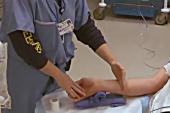Ultrasound for Femoral Access? Neutral Results vs Common Sense: UNIVERSAL
UNIVERSAL missed its primary endpoint, but one investigator likened its use to wearing a seatbelt that’s already in the car.

BOSTON, MA—Ultrasound guidance for femoral access does not appear to reduce bleeding or vascular complications but does reduce the risk of venipuncture and lowers the number of arterial puncture attempts, according to new randomized data.
Transradial access is the gold standard for most cardiac procedures, but in the event of radial artery occlusion or need for large-bore access, the femoral artery is the most common alternative and optimizing entry remains an important goal.
“We still need femoral access,” said Sanjit S. Jolly, MD, MSc (Population Health Research Institute, Hamilton, Canada), who presented the results of the UNIVERSAL trial today at TCT 2022. “We need to preserve that skill and so perhaps ultrasound guidance can [help us] do this. We know that ultrasound is only used in about a third of cases in surveys in the US, but we all have ultrasound machines in the cath labs.”
Although the trial, which was simultaneously published in JAMA Cardiology, did not meet its primary endpoint, Jolly said the effect of ultrasound “was in the right direction,” especially in that it showed significant benefit for the primary endpoint in the subgroup of patients who received closure devices.
“It's kind of like wearing a seatbelt you already have,” he said. “It's already in the car, . . . and I think it will have an impact. It's having an impact in our lab and it's the next generation that actually is changing practice. The fellows say, ‘I want to use ultrasound,’ and it's the older guy in the corner who says, ‘I've been doing this for 30 years, you don't need it.’ And this kind of iterative steps takes us forward.”
It's having an impact in our lab and it's the next generation that actually is changing practice. Sanjit S. Jolly
Commenting on the study for TCTMD, Mauricio G. Cohen, MD (University of Miami Hospital, FL), who served as senior author on a 2017 survey showing that only 27% of operators use ultrasound guidance for femoral access, said he hopes physicians won’t take the wrong message from this study. “I hope that this trial will not reinforce people who are not using ultrasound to continue an antiquated and obsolete practice based on pride and ego,” he said, noting that ultrasound guidance is standard practice for femoral procedures in his cath lab. “I hope that people are going to see the light, or the ultrasound, and continue to learn and continue to expand.”
In an accompanying editorial, Alexander C. Fanaroff, MD, MHS, and Jay Giri, MD, MPH (both University of Pennsylvania, Philadelphia), agree. “Interventional cardiologists should not use the primary null results of UNIVERSAL to argue against routine ultrasonography-guided femoral access for coronary angiography and PCI, and in favor of fluoroscopically-guided access,” they write. “The anatomic rationale is too strong, and the combined weight of evidence from nine clinical trials that ultrasonography guidance reduces vascular complications is too compelling to argue otherwise.”
UNIVERSAL Outcomes
For the study, Jolly and colleagues randomized 621 patients (mean age 71 years; 25.4% female) from two Canadian centers who were undergoing coronary angiography or PCI to have their procedures with ultrasonography guidance (n = 311) or without (n = 310). There was an overall high burden of comorbidity with 51% having prior MI, 42% with diabetes, 45% with prior PCI, 57% with prior CABG, 19% with atrial fibrillation, and 18% with peripheral vascular disease. In total, 14% of patients underwent chronic total occlusion PCI.
The rate of crossover was 2.3% from no ultrasound to ultrasound and 0.3% from ultrasound to no ultrasound. About half of all procedures were performed by interventional cardiology fellows with the other half done by attendings. Each operator was approved for inclusion in the study after performing 10 cases. Closure devices were used in 52.1% of patients.
The primary composite endpoint of BARC 2, 3, or 5 bleeding or major vascular complications at 30 days did not differ between the study groups. However, procedures in the ultrasound group had better first-pass success and fewer arterial puncture attempts and accidental venipunctures. The time to access was similar for both the ultrasound and no ultrasound groups.
30-Day and Procedural Outcomes
|
|
Ultrasound |
No Ultrasound |
OR |
95% CI |
|
|
(n = 311) |
(n = 310) |
|
|
|
BARC 2, 3, or 5 Bleeding or |
12.9% |
16.1% |
0.77 |
0.49-1.20 |
|
BARC 2, 3, or 5 Bleeding |
10.0% |
10.7% |
0.93 |
0.55-1.56 |
|
Major Vascular Complications |
6.4% |
9.4% |
0.67 |
0.37-1.20 |
|
First-pass Success |
86.6% |
70.0% |
2.76 |
1.82-4.12 |
|
Number of Arterial |
1.2 |
1.4 |
-0.26* |
-0.37 to -0.16 |
|
Accidental Venipuncture |
3.1% |
11.7% |
0.24 |
0.12-0.50 |
|
Time to Access, seconds |
114 |
129 |
-15.1* |
-45.9-15.8 |
*mean difference
There were no differences in prespecified subgroup analyses with the exception of a significant benefit observed for the primary endpoint with ultrasound guidance for those who received closure devices (11.8% vs 23.4%; OR 0.44; 95% CI 0.23-0.82). There was also a nonsignificant trend of benefit for ultrasound in cases where the attending interventional cardiologist was the lead operator (10.2% vs 17.8%; OR 0.52; 95% CI 0.25-1.07).
“I think it's very clear that like with anything, expertise is important,” Jolly told TCTMD. “Had we had all the attendings do all the procedures, we probably would have been more likely to be a positive trial.”
I hope that this trial will not reinforce people who are not using ultrasound to continue an antiquated and obsolete practice based on pride and ego. Mauricio G. Cohen
Responding to that speculation during a press conference, Ajay Kirtane, MD (NewYork-Presbyterian/Columbia University Irving Medical Center, New York, NY), asked, facetiously, if that notion wasn’t “a little counterintuitive” given that attendings are supposed to be “really good at what they do. [They] should not have an effect because they should be so good at getting femoral access without the ultrasound.”
“We always overestimate our own abilities,” Jolly responded. “This is humbling.”
Additionally, when the researchers combined their findings in a meta-analysis with other available randomized data for a total of 4,410 patients, they found that ultrasound guidance reduced both the primary endpoint (RR 0.58; 95% CI 0.43-0.76) and major vascular complications (RR 0.49; 95% CI 0.34-0.69).
“We need to focus on training the current generation of interventional cardiologists as well as the next generation,” Jolly concluded, adding that a limitation of the study is that the trainees included in the study are “still on a learning curve” regardless of the number of cases they had performed. “Finally, we do know that if you don’t touch the femoral artery, you’re not going to cause a complication. So transradial is the best way to prevent complications related to the femoral artery. But if you can't do transradial for whatever reason . . . , ultrasound guided access [for the femoral artery] is your next best thing.”
Larger Study Needed
If he had the chance to redesign the study, Jolly said he would have included more patients. It’s also possible that the endpoint, by including BARC 2 bleeding, captured events like hematoma or oozing that require medical attention but aren’t necessarily indications of a serious problem.
“Looking at more important outcomes of a larger trial likely would have seen a larger effect,” he said.
During the press conference, Roxana Mehran, MD (Icahn School of Medicine at Mount Sinai, New York, NY), said it was also possible that combining bleeding and vascular complications for the primary endpoint might have caused “some noise.” If the trial were to be repeated in the future, she suggested, larger numbers would help, but disentangling those endpoints is “definitely is something to think about.”
Kirtane noted that, despite the neutral results of this trial, patient perspectives should be considered. “If you ask a patient or if it's your mom going for a procedure, and you say your doctor has the opportunity to actually visualize the artery when you go in or they can kind of poke more times and do it without visualization,” he said with a shrug suggesting the obvious answer.
Fanaroff and Giri agree. “Any interventional cardiologist undergoing femoral access would request ultrasonography guidance from an operator well versed in the technique, just as they would refuse to jump out of an airplane without a parachute,” they write. “Guidelines should reflect this reality, and more importantly, so should the care we offer patients.”
Cohen also likened the decision to use ultrasound as deciding to “drive with your eyes closed or your eyes open,” especially as femoral procedures have become less common.
He added that he also would like to see greater use of micropuncture to further foolproof ultrasound use. “People who are embracing the #safefemoral approach are embracing the use of micropuncture,” Cohen said. “It's true, however, that micropuncture has never been shown to be beneficial and more effective. But . . . it's just common sense. If you know exactly where you're sticking, then you can actually stick in the right place.”
Yael L. Maxwell is Senior Medical Journalist for TCTMD and Section Editor of TCTMD's Fellows Forum. She served as the inaugural…
Read Full BioSources
Jolly SS, AlRashidi S, d’Entremont M-A, et al. Routine ultrasonography guidance for femoral vascular access for cardiac procedures: the UNIVERSAL randomized clinical trial. JAMA Cardiol. 2022;Epub ahead of print.
Fanaroff AC, Giri J. Fluoroscopic guidance for femoral artery access—pushing patients out of the plane without a parachute? JAMA Cardiol. 2022;Epub ahead of print.
Disclosures
- Jolly and Fanaroff report no relevant conflicts of interest.
- Giri reports serving on advisory boards and receiving research funds to his institution from Abiomed, Boston Scientific, Abbott Vascular, Inari Medical, and Recor Medical.
- Cohen reports receiving consulting honoraria from Cordis, Merit Medical, Terumo Medical, and Medtronic and having ownership of Accumed Radial Systems.




Jan Kovac